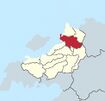User:Geordinia/sandbox12: Difference between revisions
Jump to navigation
Jump to search
(Replaced content with "Category:Rajyaghar {{Infobox subdivision type | name = Union States and Federal Territories | map = RajyagharStateMap.png | category...") Tag: Replaced |
|||
| Line 1: | Line 1: | ||
[[Category: Rajyaghar]] | [[Category:Rajyaghar]] | ||
{{Infobox subdivision type | |||
{{Infobox | | name = Union States and Federal Territories | ||
| | | map = RajyagharStateMap.png | ||
| | | category = {{wp|Federated State}} | ||
| territory = {{Flag|Rajyaghar}} | |||
| start_date = | |||
| current_number = 11 Union States<br>2 Federal Territories<br>1 Autonomous Princely State | |||
| | | number_date = | ||
| government = {{wp|State government}} | |||
| subdivision = {{wp|Province}}, {{wp|District}}, {{wp|Commune}} | |||
| | |||
| | |||
| | |||
| | |||
| | |||
| | |||
}} | }} | ||
{{Politics of Rajyaghar}} | |||
== List of Administrative Divisions == | |||
{| class="wikitable sortable mw-collapsible" border="1" style="font-size:90%" | |||
! Type | |||
! Name | |||
! Region | |||
! Capital | |||
! Population | |||
! Seats in <br/> [[Shahee Sansad]] | |||
! Rajakumar | |||
! First Minister | |||
== | ! class="unsortable" | Location | ||
|- | |||
| bgcolor="lightgray" | Union State | |||
| [[Sanyukt]] | |||
| The Core | |||
| [[Kentola]] | |||
| 9,690,722 | |||
| align="center" | 96 | |||
| Shivaji Rajana | |||
| Goivand Baria | |||
|[[File:Sanyukt Map.jpg|105px]] | |||
|- | |||
| bgcolor="darkgray" | Federal Territory | |||
| [[Bishnupur]] | |||
| The Core | |||
| [[Bishnupur]] | |||
| 3,160,018 | |||
| align="center" | 31 | |||
| Panditrao XX | |||
| Panditrao XX | |||
|[[File:Bishnupur Map.jpg|105px]] | |||
|- | |||
|} | |||
= | |||
| | |||
[[File: | |||
[[ | |||
|align = | |||
| | |||
| | |||
| | |||
| | |||
[[ | |||
{{Rajyaghar}} | {{Rajyaghar}} | ||
Revision as of 16:02, 14 July 2023
| Union States and Federal Territories | |
|---|---|
 | |
| Category | Federated State |
| Location | |
| Number | 11 Union States 2 Federal Territories 1 Autonomous Princely State |
| Government | State government |
| Subdivisions | Province, District, Commune |
 |
|---|
| This article is part of a series on the politics and government of Rajyaghar |
List of Administrative Divisions
| Type | Name | Region | Capital | Population | Seats in Shahee Sansad |
Rajakumar | First Minister | Location |
|---|---|---|---|---|---|---|---|---|
| Union State | Sanyukt | The Core | Kentola | 9,690,722 | 96 | Shivaji Rajana | Goivand Baria | 
|
| Federal Territory | Bishnupur | The Core | Bishnupur | 3,160,018 | 31 | Panditrao XX | Panditrao XX | 
|